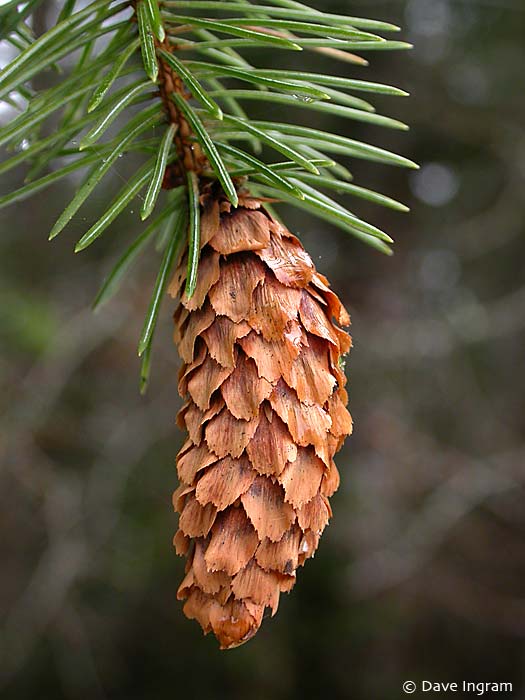
Sitka spruce (Picea sitchensis) is in the big leagues as far as trees are concerned, along with other west coast giants like Douglas-fir and western red cedar. To me, the very name “spruce” conjures up an Emily Carr-like image of a dark green, dripping forest, full of massive, ancient, awe-inspiring trees.
How to Identify Sitka Spruce
Sitka spruce is the largest of the spruce species; with strongly out-thrust limbs and a fringe of drooping branches. The spirally arranged needles are stiff and sharp, and prickly to touch. Each needle attaches to a small wooden peg at the base, which remains after the needles fall off. It is common to find spruce twigs studded with these little pegs on the forest floor. Needles may be yellow-green or blue-green in colour.
Seed cones of Sitka spruce are light brown or reddish and are thin and papery. Each scale has a wavy margin, unlike the three-pronged scales of Douglas-fir. Pollen cones (male) are small and red. Sitka spruce’s thin bark is a characteristic field mark. Typically it is grey or rusty brown and has shingle-like scales. The bark of a young tree does not differ much from an old tree.
Sitka Spruce Habitat
Sitka spruce thrives along the coast from the Aleutian Islands of Alaska down to Northern California. It grows primarily at low elevations (up to 400 metres) and does not stray much beyond 80 km inland from the coast. Unlike many trees, Sitka spruce can tolerate salt spray, and in the words of author John Vaillant forms “the first line of defense between sea and forest” on BC’s wind-whipped outer coast.
The largest and most ancient spruces are common along river floodplains. The tallest spruce in BC is located in Carmanah Walbran Provincial Park, and is 96 metres tall. The spruce tree with the largest circumference (13.94 metres) in BC resides on the Brooks Peninsula. Typically spruces grow 70 metres tall and 2 metres in diameter.
The largest spruces are comparable in size to the largest Douglas-firs. Douglas-fir, however, lives twice as long as spruce. Sitka spruce is the shortest-lived of the coastal conifers, and rarely exceeds 400 years in age. Most succumb to velvet top fungus before this time.
Spruce seedlings grow best in organic soils, especially rotten logs and stumps. Often, one may see a line of mature trees that all grew up along the same nurse log. A “forest colonnade” is another name for this line of trees.
A Useful Tree
First Nations peoples used Sitka spruce for many purposes. The Haida are renown for their watertight spruce root baskets and hats. Roots were also used for fishing line and twine. Spruce pitch was used as a healing salve, and to caulk and waterproof boats. The sharp spruce needles were thought to protect from evil. Inner spruce bark and new shoots were sometimes consumed as a source of vitamin C.
Captain Cook (1728-1779) used the knowledge of the coastal peoples to prevent his crew from getting scurvy. Cook was successful in making a vitamin C-rich spruce beer from spruce buds and molasses.
Sitka spruce has always been known for its wood, because it is light, strong and flexible. During World War II, Sitka spruce was the ideal wood for aircraft construction. Spruce was the primary material of Howard Hughes’s famous flying boat, the “Spruce Goose.” Spruce wood also has excellent acoustic capabilities, and is used for making violins, guitars, and the soundboards of pianos.
Sitka Spruce is one of the most majestic trees of the west coast, and has garnered worldwide attention in recent decades during struggles to protect the last remaining stands of old growth trees in places such as the Carmanah Valley. “Big trees” are always a popular subject, and are an important part of our identity as British Columbians.
Let’s hope that there will be always be places where we can see the trees as Emily Carr did, alive with primeval majesty and mystery.
About the Contributor:
Jocie Brooks is a naturalist and writer based in the Comox Valley, Vancouver Island, British Columbia.
